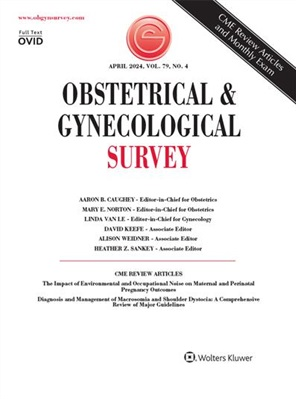Sacrospinous Fixation and Vaginal Uterosacral Suspension-Evaluation in Uterine Preservation Surgery
IF 3.6
4区 医学
Q1 OBSTETRICS & GYNECOLOGY
引用次数: 0
Abstract
ABSTRACT Although hysterectomy is traditionally performed at the time of pelvic organ prolapse repair for apical prolapse, women are increasingly interested in uterine preservation during pelvic organ prolapse surgical management. Approximately 36% to 60% of women indicate interest in uterine preservation, assuming equal efficacy. This has led to more uterus-preserving prolapse repairs (hysteropexy) being performed. After the removal of mesh products from the US market in 2019, transvaginal native tissue techniques are commonly used for hysteropexy. This study aimed to compare 6-week and 1-year anatomical failure rates between vaginal uterosacral ligament hysteropexy and sacrospinous ligament hysteropexy. Secondary outcomes included retreatment for prolapse, symptoms of recurrent prolapse, and perioperative adverse event rates in these 2 groups. This was a multicenter retrospective cohort study of patients undergoing vaginal uterosacral hysteropexy (USHP) or sacrospinous hysteropexy (SSHP) with a urogynecologist between January 1, 2015 and December 31, 2019. The pool of patient data was extrapolated from 4 geographically unique urban locations. Patient identification took place via querying the respective electronic medical records for the current procedural terminology codes of extraperitoneal colpopexy (57,282, SSHP) and intraperitoneal colpopexy (57,283, USHP). These operative reports underwent review in order to confirm that each patient had a uterus at time of surgery, underwent either USHP or SSHP, and did not undergo concurrent hysterectomy. Exclusion criteria included patients undergoing different types of uterine-preserving procedures or patients with less than 6 weeks of follow-up. The study included 147 patients undergoing SSHP and 114 having USHP over 5 years at the 4 clinical sites. The study population included mostly nonsmoking (179, 68.6%), White (224, 85.5%) patients with no history of pelvic surgery (142, 54.4%), and a mean Charleston Comorbidity Index score of 2. Overall, USHP patients exhibited a higher likelihood to undergo concurrent anterior repair, posterior repair, and incontinence procedures. The follow-up rate was 95% at 6 postoperative weeks with 4 anatomic failures. Not all patients had formal prolapse quantitation examinations recorded. However, only 32% (83/261) of patients were available for follow-up at 1 year after surgery when 10 patients met criteria for anatomic failure. Notably, although there was no statistically significant difference between failure rates for SSHP and USHP at either time point, there were roughly 3 times as many failures for USHP compared with SSHP, despite the SSHP representing a larger portion of the total cohort. At 1 year, however, 26 patients had undergone retreatment for prolapse, with 12 undergoing hysterectomy (11 due to prolapse, 1 due to colorectal cancer debulking). Of those undergoing hysterectomy, 10 were from the SSHP cohort, whereas 1 was from the USHP cohort. The 1 year anatomic outcomes presumably included prolapse assessments after these salvage surgeries. One year after vaginal native tissue hysteropexy, only 1 in 3 patients were available for follow-up, but this limited cohort demonstrated that no differences for prolapse recurrence between SSHP and UHSP. Adverse events incidence rates were low, with only 5% of patients undergoing subsequent hysterectomy for prolapse. Any next step in research should include more rigorous prospective trials.骶棘固定和阴道子宫骶悬吊-子宫保留手术的评价
虽然子宫切除术传统上是在盆腔器官脱垂修复根尖脱垂时进行的,但女性在盆腔器官脱垂手术治疗中越来越关注子宫保留。大约36%到60%的女性表示对子宫保存感兴趣,假设效果相同。这导致更多的保留子宫脱垂修复(子宫切除术)被执行。在2019年网状产品从美国市场下架后,经阴道原生组织技术通常用于子宫切除术。本研究旨在比较阴道子宫骶韧带宫内固定术和骶棘韧带宫内固定术在6周和1年内的解剖失败率。次要结局包括脱垂的再治疗、复发性脱垂的症状和两组患者围手术期不良事件发生率。这是一项多中心回顾性队列研究,研究对象是在2015年1月1日至2019年12月31日期间在泌尿妇科医生处接受阴道子宫骶部子宫切除术(USHP)或骶棘部子宫切除术(SSHP)的患者。患者数据池是从4个地理上独特的城市地点推断出来的。通过查询各自的电子病历来确定患者身份,以获得腹膜外阴道灌封术(57,282,SSHP)和腹膜内阴道灌封术(57,283,USHP)的现行程序术语代码。对这些手术报告进行了回顾,以确认每位患者在手术时都有子宫,接受了USHP或SSHP,并且没有同时进行子宫切除术。排除标准包括接受不同类型子宫保留手术的患者或随访时间少于6周的患者。该研究包括4个临床地点的147例SSHP患者和114例USHP患者,时间超过5年。研究人群主要包括不吸烟(179例,68.6%)、无盆腔手术史的White(224例,85.5%)患者(142例,54.4%),平均查尔斯顿合并症指数评分为2分。总的来说,USHP患者更有可能同时进行前路修复、后路修复和尿失禁手术。术后6周随访率95%,解剖失败4例。并非所有患者均有正式的脱垂定量检查记录。然而,只有32%(83/261)的患者在术后1年随访,其中10例患者符合解剖衰竭标准。值得注意的是,尽管在任何一个时间点,SSHP和USHP的失败率没有统计学上的显著差异,但USHP的失败率大约是SSHP的3倍,尽管SSHP在整个队列中占更大的比例。然而,1年后,26例患者因脱垂再次接受治疗,其中12例接受子宫切除术(11例因脱垂,1例因结直肠癌减积)。在接受子宫切除术的患者中,10例来自SSHP组,1例来自USHP组。1年的解剖结果可能包括这些挽救性手术后的脱垂评估。阴道原生组织子宫切除术一年后,只有1 / 3的患者可以随访,但这个有限的队列显示SSHP和UHSP在脱垂复发方面没有差异。不良事件发生率低,只有5%的患者因脱垂而接受子宫切除术。下一步的研究应该包括更严格的前瞻性试验。
本文章由计算机程序翻译,如有差异,请以英文原文为准。
求助全文
约1分钟内获得全文
求助全文
来源期刊
CiteScore
2.70
自引率
3.20%
发文量
245
审稿时长
>12 weeks
期刊介绍:
Each monthly issue of Obstetrical & Gynecological Survey presents summaries of the most timely and clinically relevant research being published worldwide. These concise, easy-to-read summaries provide expert insight into how to apply the latest research to patient care. The accompanying editorial commentary puts the studies into perspective and supplies authoritative guidance. The result is a valuable, time-saving resource for busy clinicians.

 求助内容:
求助内容: 应助结果提醒方式:
应助结果提醒方式:


